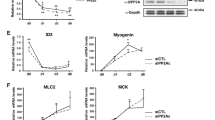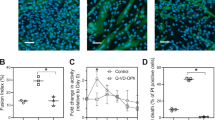Abstract
We have previously shown that the adenovirus E1A oncogene can reactivate the cell cycle in terminally differentiated cells. Current models imply that much or all of this E1A activity is mediated by the release of the E2F transcription factors from pocket-protein control. In contrast, we show here that overexpression of E2F-1, E2F-2 and E2F-4, or a chimeric E2F-4 tethered to a nuclear localization signal cannot reactivate postmitotic skeletal muscle cells (myotubes). This is not due to lack of transcriptional activity, as demonstrated on both a reporter construct and a number of endogenous target genes. Although cyclin E was strongly overexpressed in E2F-transduced myotubes, it lacked associated kinase activity, possibly explaining the inability of the myotubes to enter S phase and accumulate cyclin A. Although E2F is not sufficient to trigger DNA synthesis in myotubes, its activity is necessary even in the presence of E1A, as dominant-negative DP-1 mutants inhibit E1A-mediated cell cycle reentry. Our data show that, to reactivate myotubes, E1A must exert other functions, in addition to releasing E2F. They also establish mouse myotubes as an experimental system uniquely suited to study the most direct E2F functions in the absence of downstream cell cycle effects.
This is a preview of subscription content, access via your institution
Access options
Subscribe to this journal
Receive 50 print issues and online access
$259.00 per year
only $5.18 per issue
Buy this article
- Purchase on Springer Link
- Instant access to full article PDF
Prices may be subject to local taxes which are calculated during checkout






Similar content being viewed by others
References
Alevizopoulos K, Catarin B, Vlach J and Amati B. . 1998 EMBO J. 17: 5987–5997.
Bader D, Masaki T and Fischman DA. . 1982 J. Cell Biol. 95: 763–770.
Blau HM, Pavlath GK, Hardeman EC, Chiu C-P, Silberstein L, Webster SG, Miller SC and Webster C. . 1985 Science 230: 758–766.
Cardoso MC, Leonhardt H and Nadal-Ginard B. . 1993 Cell 74: 979–992.
Crescenzi M, Soddu S, Sacchi A and Tato F. . 1995a Ann. NY Acad. Sci. 752: 9–18.
Crescenzi M, Soddu S and Tato F. . 1995b J. Cell. Physiol. 162: 26–35.
de la Luna S, Burden MJ, Lee CW and La Thangue NB. . 1996 J. Cell Sci. 109: 2443–2452.
DeGregori J, Leone G, Miron A, Jakoi L and Nevins JR. . 1997 Proc. Natl. Acad. Sci. USA 94: 7245–7250.
DeGregori J, Leone G, Ohtani K, Miron A and Nevins JR. . 1995 Genes Dev. 9: 2873–2887.
Dyson N. . 1998 Genes Dev. 12: 2245–2262.
Endo T and Nadal-Ginard B. . (1989). In: Kedes LH and Stockdale FE. (eds Cellular and molecular biology of muscle development: UCLA Symposia on Molecular and Cellular Biology. Alan R. Liss, Inc: New York. pp. 95–104.
Fogel M and Defendi V. . 1967 Proc. Natl. Acad. Sci. USA 58: 967–973.
Harlow E, Whyte P, Franza Jr RB and Schley C. . 1986 Mol. Cell. Biol. 6: 1579–1589.
Helin K, Harlow E and Fattaey A. . 1993a Mol. Cell. Biol. 13: 6501–6508.
Helin K, Wu C-L, Fattaey AR, Lees JA, Dynlacht BD, Ngwu C and Harlow E. . 1993b Genes Dev. 7: 1850–1861.
Helin K. . 1998 Curr. Opin. Gen. Dev. 8: 23–35.
Johnson DG, Schwarz JK, Cress DW and Nevins JR. . 1993 Nature 365: 349–352.
Kirshenbaum LA and Schneider MD. . 1995 J. Biol. Chem. 270: 7791–7794.
Kirshenbaum LA, Abdellatif M, Chakraborty S and Schneider MD. . 1996 Dev. Biol. 179: 402–411.
Lindeman GJ, Gaubatz S, Livingston DM and Ginsberg D. . 1997 Proc. Natl. Acad. Sci. USA 94: 5095–5100.
Lukas J, Herzinger T, Hansen K, Moroni MC, Resnitzky D, Helin K, Reed SI and Bartek J. . 1997 Genes Dev. 11: 1479–1492.
Lukas J, Petersen BO, Holm K, Bartek J and Helin K. . 1996 Mol. Cell. Biol. 16: 1047–1057.
Magae J, Wu CL, Illenye S, Harlow E and Heintz NH. . 1996 J. Cell Sci. 109: 1717–1726.
Müller H, Moroni MC, Vigo E, Petersen BO, Bartek J and Helin K. . 1997 Mol. Cell. Biol. 17: 5508–5520.
Ohtsubo M, Theodoras AM, Schumacher J, Roberts JM and Pagano M. . 1995 Mol. Cell. Biol. 15: 2612–2624.
Okazaki K and Holtzer H. . 1996 Proc. Natl. Acad. Sci. USA 56: 1484–1490.
Pagano M, Pepperkok R, Verde F, Ansorge W and Draetta G. . (1992) EMBO J. 11: 961–971.
Puri PL, Balsano C, Burgio VL, Chirillo P, Natoli G, Ricci L, Mattei E, Graessman A and Levrero M. . 1997 Oncogene 14: 1171–1184.
Puri PL, Cimini L, Fulco M, Zimmerman C. La Thangue NB, Giordano A, Graessmann A and Levrero M. . 1998 Cancer Res. 58: 1325–1331.
Shan B and Lee W-H. . 1994 Mol. Cell. Biol. 14: 8166–8173.
Tiainen M, Pajalunga D, Ferrantelli F, Soddu S, Salvatori G, Sacchi A and Crescenzi M. . 1996a Cell Growth Diff. 7: 1039–1050.
Tiainen M, Spitkovsky D, Jansen-Dürr P, Sacchi A and Crescenzi M. . 1996b Mol. Cell. Biol. 16: 5302–5312.
Trivedi RA and Dickson G. . 1995 J. Neurochem. 64: 2230–2238.
Verona R, Moberg K, Estes S, Starz M, Vernon JP and Lees JA. . 1997 Mol. Cell. Biol. 17: 7268–7282.
Wang H-GH, Rikitake Y, Corrigan Carter M, Yaciuk P, Abraham SE, Zerler B and Moran E. . 1993 J. Virol. 67: 476–488.
Weinberg RA. . 1995 Cell 81: 323–330.
Whyte P, Williamson NM and Harlow E. . 1989 Cell 56: 67–75.
Wu CL, Classon M, Dyson N and Harlow E. . 1996 Mol. Cell. Biol. 16: 3698–3706.
Yaffe D and Gershon D. . 1967 Nature 215: 421–424.
Zerfass-Thome K, Schulze A, Zwerschke W, Vogt B, Helin K, Bartek J, Henglein B and Jansen-Dürr P. . 1997 Mol. Cell. Biol. 17: 407–415.
Acknowledgements
We thank the colleagues who donated reagents for this work and S Soddu for reviewing the manuscript. D Pajalunga is a recipient of a FIRC fellowship. This work has been supported by Telethon grant no. 761 and an AIRC grant to M Crescenzi, and an AIRC grant to K Helin.
Author information
Authors and Affiliations
Rights and permissions
About this article
Cite this article
Pajalunga, D., Tognozzi, D., Tiainen, M. et al. E2F activates late-G1 events but cannot replace E1A in inducing S phase in terminally differentiated skeletal muscle cells. Oncogene 18, 5054–5062 (1999). https://doi.org/10.1038/sj.onc.1202897
Received:
Revised:
Accepted:
Published:
Issue Date:
DOI: https://doi.org/10.1038/sj.onc.1202897



